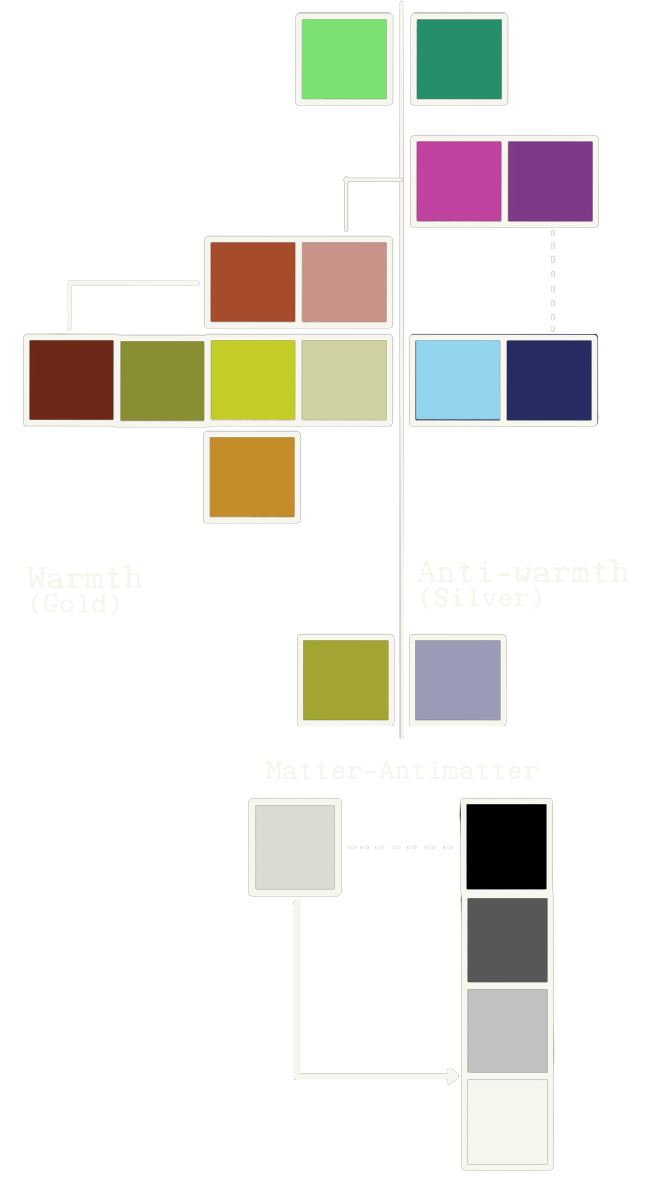
The cards emerge from the principles described in the previous chapter, but they are not the design basis in whole; and although the Forces and Matter described therein do find direct representation in the imagery of the cards, it is rather the interactions between them that actually produce the cards.
The Quantum Realm is built on chaos. Chaos is not anarchy: it is randomness within a set of rules. Reality is nonetheless a smearing of probabilities in which many things may at once be true, though some more true than others.
This Chaos is much more operable at the bare-metal computational level of the Unconscious Mind. These computations, governed by Chaos, are not deterministic like those of a digital computer but instead frequently return the unexpected as output.
The cards in this deck are the product of Chaos operating within Rules. They are limited by palette. The numerical sequences, and the broad meanings, are established in traditions of tarot cartomancy. But the imagery in each of them is an emergence of non-deterministic Quantum interactions in the Unconscious Mind, resolved into a fixed physical form. In another reality they will look quite different, though within the same parameters.
The beauty of QCT is that the same methodology used to create it is reproducible by anybody so long as the same structure is followed. That the cards appear in the form they do here is a result of Chaos, operating within the broad meanings of RWS, filtering through the author’s Unconscious and, accordingly, lived experience and influences. The realities depicted here emerged through this process, but by a different hand a separate set of microcosms might have been represented instead; indeed, even if the author had drawn them on different days or in a different order! Such is the influence of Chaos even within the individual experience of every living thing.
The characters and locales on the cards are from an unknown number of worlds operating according to unknown laws of nature. It is likewise unknown at what scale their worlds exist, and of what stuff they are made: they may be spread across our own Universe, across many Universes or each may even be a tiny self-contained Universe of its own, all entangled together at the fundamental level and reflecting ours in some way.
As alien as they are, Earthly forms and symbols are abundant within them, and they are thus relatable to the Human experience. Trees, mushrooms, coffee mugs, computer screens, flowers, and cats all tread their way across these alien microcosms. They are the Universes that bridge most aptly between the author’s Unconscious and the broad meanings of each card.

The colors used in the cards are of the same unified set, counting 20 in total. They are divided into warm and anti-warm categories, along with five neutral colors.
The foundational colors are black and white, though due to unknown asymmetries in the Universe they are not equal; the warmth of the white color is a product of the predominance of matter. Matter and antimatter together annihilate in a burst of pure energy, though this effect is mediated by the other colors. The potential for massive, explosive energy is nonetheless present in each card.
There are two grays that are intermediate between white and black. Additionally, there is a “super-white” that is the only color lighter than the base white (though it is still slightly warm in tint).
As stated above, color mediates the matter-antimatter reaction. The warm and cool colors may be considered as different combinations of color and anti-color charge, which may further combine into exotic and unknown forms of matter with unknown behaviors and properties. This can be extended further with heavier forms of Quarks. Thus the cards transcend Earthly physics and forms into something alien.
The greens bridge the warm-antiwarm barrier, one being somewhat cooler than the other. Green is a color of life and harmony. The warm colors are associated with positivity, energy, enthusiasm, and wealth, but also with anger, fear, arrogance, and hatred. Orange is an isolate in this color scale, with no “darker” form but arguably no lighter form either: it is thus a neutral warm. It does not mix well with the neutral warm of Gold, to which it is extremely similar, and the two do not occur side-by-side.
The blues are of extreme high contrast, with a lighter form conveying the airy freedom of the open sky and the darker form, the unfathomable mystery of the sea. It can express deep sadness and grief, or simply the unknowable.
The purples are somewhat eccentric and form a neutral dyad. They fade into the pale pink-red and thus are a loose bridge to the warm colors, as well as more loosely still to deep blue.